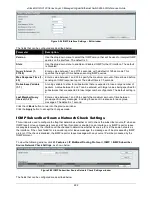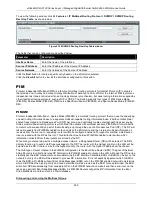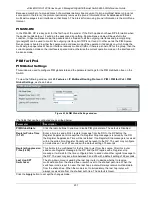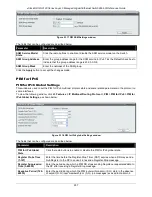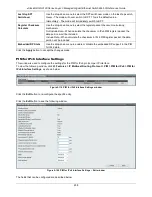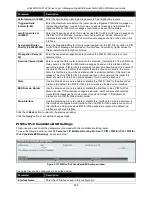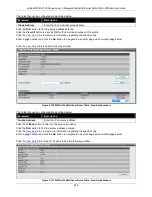
xStack® DGS-3120 Series Layer 3 Managed Gigabit Ethernet Switch Web UI Reference Guide
231
Because a member of a pruned branch of a multicast delivery tree may want to join a multicast delivery group (at
some point in the future), the protocol periodically removes the ‘prune’ information from its database and floods
multicast messages to all interfaces on that branch. The interval for removing ‘prune’ information is the Join/Prune
Interval.
PIM-SM-DM
In the PIM-SM, RP is a key point for the first hop of the sender. If the first hop does not have RP information when
the sender sends data out, it will drop the packet and do nothing. Sparse-Dense mode will be useful in this
condition. In Sparse-Dense mode, the packets can be flooded to all the outgoing interfaces and pruning/joining
(prune/graft) can be used to control the outgoing interface list if RP is not found. In other words, the PIM Sparse-
Dense mode is treated in either the sparse mode or dense mode of the operation; it depends on which mode the
multicast group operates. When an interface receives multicast traffic, if there is a known RP for the group, then the
current operation mode on the interface is sparse mode, otherwise the current operation mode on the interface will
be dense mode.
PIM for IPv4
PIM Global Settings
This window is used to configure PIM global state and the parameter settings for the PIM distribution tree on the
Switch.
To view the following window, click
L3 Features > IP Multicast Routing Protocol > PIM > PIM for IPv4 > PIM
Global Settings
, as shown below:
Figure 5-106 PIM Global Settings window
The fields that can be configured are described below:
Parameter
Description
PIM Global State
Click the radio buttons to enable or disable PIM global state. The default is Disabled.
Register Probe Time
(1-127)
Enter a time to send a NULL register message from the DR to the RP before the
Register Suppression time expires. If a Register Stop message is received by the DR,
the Register Suppression Time will be restarted. If no Register Stop message is received
within the probe time, Register Packets will be resent to the RP. The user may configure
a time between 1 and 127 seconds with a default setting of 5 seconds.
Register Suppression
Time (3-255)
This field is to be configured for the first hop router from the source. After this router
sends out a Register message to the RP, and the RP replies with a Register stop
message, it will wait for the time configured here to send out another register message to
the RP. The user may set a time between 3 and 255 with a default setting of 60 seconds.
Last Hop SPT
Switchover
The drop-down menu is used by the last hop router to decide whether to receive
multicast data from the shared tree or switch over to the shortest path tree. When the
switchover mode is set to never, the last hope router will always receive multicast data
from the shared tree. When the mode is set to immediately, the last hop router will
always receive data from the shortest path tree. The default is
Never
.
Click the
Apply
button to accept the changes made.
Содержание xStack DGS-3120 Series
Страница 1: ......






